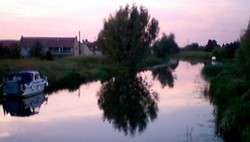Prickwillow
Coordinates: 52°24′54″N 0°20′24″E / 52.415°N 0.340°E
Originally a small hamlet on the banks of the River Great Ouse, but now on the banks of the River Lark since re-organisation of the river system, the village of Prickwillow has an estimated mid-2005 population of 440.[1] It lies in the south of the Fens, 4 miles (6.4 km) east of the city of Ely (where the population is included) in Cambridgeshire, England, and is home to Prickwillow Museum,[2] which tells the story of the changing face of Fenland. Prickwillow Museum is housed in the old pumping station and contains a major collection of working pumping engines. The village is also home to the Ely Group of Internal Drainage Boards.[3]
History
Evidence for very early settlements near Prickwillow was unearthed in the 1930s, when an archaeological dig took place at Plantation Farm and Peacocks Farm, by the A1101. This provided evidence for Roman and three levels of prehistoric settlements just to the east of the village.
The modern parish of Prickwillow was formed in 1878. The name is said to be a reference to the 'prickets' of willow—long thin skewers used to make thatch—that grew in the surrounding marshy land.
Prior to the nineteenth century, the River Great Ouse flowed east of Ely as far as Prickwillow, before rejoining the modern course of the Ouse at Littleport. In 1829-30, however, the river was diverted north from Ely,[4] and the original channel ploughed and filled in. Today's village lies on the site of the old riverbank,[5] with evidence of the original course remaining in the name of the roads (e.g. Old Bank) and the meandering edges of the neighbouring fields (visible on this satellite image). Astbury terms such old watercourses rodhams and another East Anglian village, Benwick is similarly built on a rodham.[6]

Drainage
Much of the Prickwillow area lies below sea level so, in order to ensure that the land remained arable, a series of steam pumping engines were installed at the base of the newly dug drain, linked to the River Lark. The first of these was the steam side-lever engine, installed in 1831. This was replaced in the 1880s by the steam beam engine, itself replaced in 1924 by the powerful Mirrlees, Bickerton and Day Diesel. With a weight of 25 tonnes and a nominal power output of 250bhp at 250rpm, this engine ran until the 1970s, when it was replaced with automatic electric pumps.
The Mirrlees diesel engine remains the centrepiece of the Prickwillow Museum,[7] and is believed to be the only example of an air-blast injection engine remaining in working order. The museum also contains other diesel engines, dating from 1919, recovered from other local pumping stations, and restored by volunteers. The Diesel pumping engines are demonstrated to interested visitors on several days throughout the year.
Prickwillow is the current office and workshop base for the Ely Group of Internal Drainage Boards who maintain the current electric pumping station in Prickwillow and surrounding watercourses. The group consists of ten internal drainage boards (IDBs) whose boundaries extend to the New Bedford River and Welney to the west and Mildenhall and Lakenheath to the east. The IDBs provide water level and flood risk management within their districts.
In the 1920s, it was reported that the constant draining of the land resulted in the peaty soil sinking by 2 inches (51 mm) every year. The local school buildings and St. Peter's Church, built in 1862 and 1866 respectively, as well as many of the local houses, were built on piles to ensure stable foundations. Two steps were built up to the front door of the vicarage, but many more had to be added as the land gradually sank. In addition, owing to the high water table, church burials take place in the more elevated settlement of Ely.
The B1104 between Prickwillow and neighbouring Isleham is reputedly the most subsidence affected road in the country; so undulating is the 6.4-mile (10.3 km) drive that some have experienced bouts of motion sickness equal to that of seasickness.
Other
Prickwillow had broadband fibre provision installed within the village in 2015. A local company, 4SG Telecom also provides broadband in the village - 4SG Telecom.[8]
To the east of the village are two large houses - the Vicarage and Sindalthorpe House. Sindalthorpe was built in 1849, and was the scene of some scandal. The owner used to invite young London couples up to stay and lay on entertainment - shooting, hunting, fishing and the like - for the gentlemen in question, and then desport himself with their wives. More recently it was the Bedford Farm until around 1985, when it moved into private ownership. Similarly, a mile further out is Shippea Hill Farm, now part of Frederic Hiam Ltd, with the farmhouse again in private ownership.
References
- ↑ Cambridgeshire County Council Research group. "Cambridgeshire Population and Dwelling Stock Estimates and Forecasts". Accessed 7 May 2007.
- ↑ Prickwillow Museum
- ↑ Ely Group of Internal Drainage Boards Website
- ↑ Fowler, Gordon. (1934). The Extinct Waterways of the Fens: A paper read at the Afternoon Meeting of the Society on 13 November 1983. The Geographical Journal.
- ↑ "Diamond 44 -- A Celebration of the 1944 University Boat Race". Accessed 7 May 2007.
- ↑ 1987, Prickwillow on plate 41 and Benwick on plates 34–38.
- ↑ Prickwillow Museum
- ↑ 4SG Telecom CEO 2013
- "UK & Ireland Genealogy". Accessed 7 May 2007.
- "Cambridgeshire Genealogy". Accessed 7 May 2007.
External links
| Wikimedia Commons has media related to Prickwillow. |
- HIAM Sports & Social Club
- Website of Prickwillow Village Council
- Prickwillow Museum
- Ely Group of Internal Drainage Boards

